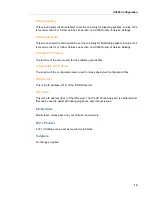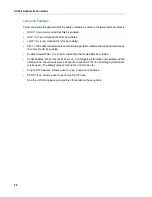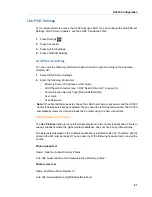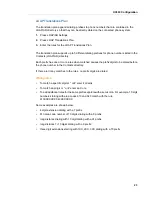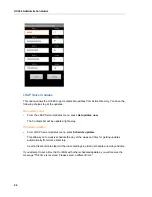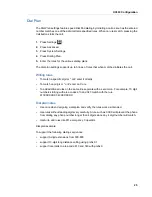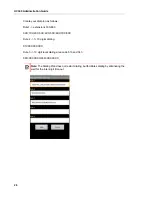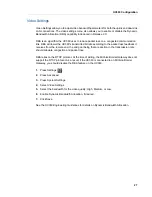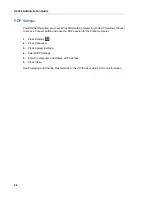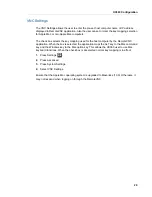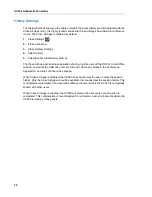
UC360 Configuration
15
Misc
•
Registration Time Out — the SIP registration time out value in seconds. It is recommended
to leave this at the factory default setting of 3600 seconds.
•
Keep Alive Interval — the SIP keep-alive interval in seconds. It is recommended to leave
this at the factory default setting of 0, which is disabled.
•
Proxy Server Address — the SIP Proxy server IP address (IPv4) if you have a server that
is used when interoperating with a 3rd party server, for example, BroadSoft. See the Mitel
SIP Centre of Excellence (SIP CoE).
•
Proxy Server address for Dial URI — the internal IP address of the gateway or SIP Outbound
Proxy server address in the format FQDN | IP [:port]. This is the address of the SBC.
Security
•
TLS Server Validation — enable or disable the validation of TLS connections with installed
certificate authority certificates
•
Install Certificates From External Storage — install a user or CA certificate and keys for
validating TLS connections
•
Remove All Installed Certificates — remove all installed user and CA certificates and keys
TLS Server Validation
When TLS Server Validation is enabled, the certificate supplied by the SIP Server when using
the TLS transport during the TLS handshake is validated against the list of trusted root certificate
installed on the UC360.
The Mitel root certificate is the single entry in this certificate list by default on the UC360.
Install Certificates From External Storage
You can install new certificates from any.crt file (for example, mat_ca.crt in PEM format) or p12
file (PKCS12 format) in the following locations: the root directory of a USB drive, the root
directory or download directory of an sdcard.
If there are multiple.crt and/or.p12 files, you will see a list of files to choose from. Note that the
list indicates the path, including the device on which each file is present.
Upon successful installation of a certificate, the selected file is deleted on the external storage
device and will no longer appear in the above list.
If only a single file is found, you see only the information on any certificate found in that file and
have the option to name the certificate. The same process occurs with a file selected from the
above list.
Remove All Installed Certificates
If the administrator confirms they want to remove all installed certificates after selecting that
option, then the default Mitel certificate is the only that remains in the list.
Summary of Contents for UC360
Page 1: ...MITEL UC360 COLLABORATION POINT ADMINISTRATION GUIDE ...
Page 6: ...UC360 Administration Guide vi ...
Page 7: ...CHAPTER 1 UC360 NEW FEATURES ...
Page 8: ...UC360 Administration Guide 2 ...
Page 10: ...UC360 Administration Guide 4 ...
Page 11: ...CHAPTER 2 INTRODUCTION ...
Page 12: ...UC360 Administration Guide 2 ...
Page 16: ...UC360 Administration Guide 6 ...
Page 17: ...CHAPTER 3 RECOMMENDED CONFIGURATIONS ...
Page 18: ...UC360 Administration Guide 2 ...
Page 21: ...CHAPTER 4 UC360 CONFIGURATION ...
Page 22: ...UC360 Administration Guide 6 ...
Page 76: ...UC360 Administration Guide 60 ...
Page 77: ...CHAPTER 5 MCD CONFIGURATION FOR THE UC360 ...
Page 78: ...UC360 Administration Guide 62 ...
Page 88: ...UC360 Administration Guide 72 ...
Page 89: ...CHAPTER 6 5000 CP CONFIGURATION FOR THE UC360 ...
Page 90: ...UC360 Administration Guide 74 ...
Page 95: ...APPENDIX A ONVIF DEVICE MANAGER ...
Page 96: ...UC360 Administration Guide 80 ...
Page 103: ...APPENDIX B UC360 WEB SERVER ...
Page 104: ...UC360 Administration Guide 88 ...
Page 112: ...UC360 Administration Guide 96 ...
Page 113: ...APPENDIX C MASS DEPLOYMENT ...
Page 114: ...UC360 Administration Guide 98 ...
Page 121: ...APPENDIX D XML FILE FORMAT ...
Page 122: ...UC360 Administration Guide 106 ...
Page 130: ...UC360 Administration Guide 114 ...
Page 131: ...APPENDIX E MASS DEPLOYMENT CONFIGURATION FILE REFERENCE ...
Page 132: ...UC360 Administration Guide 116 ...
Page 141: ......



















